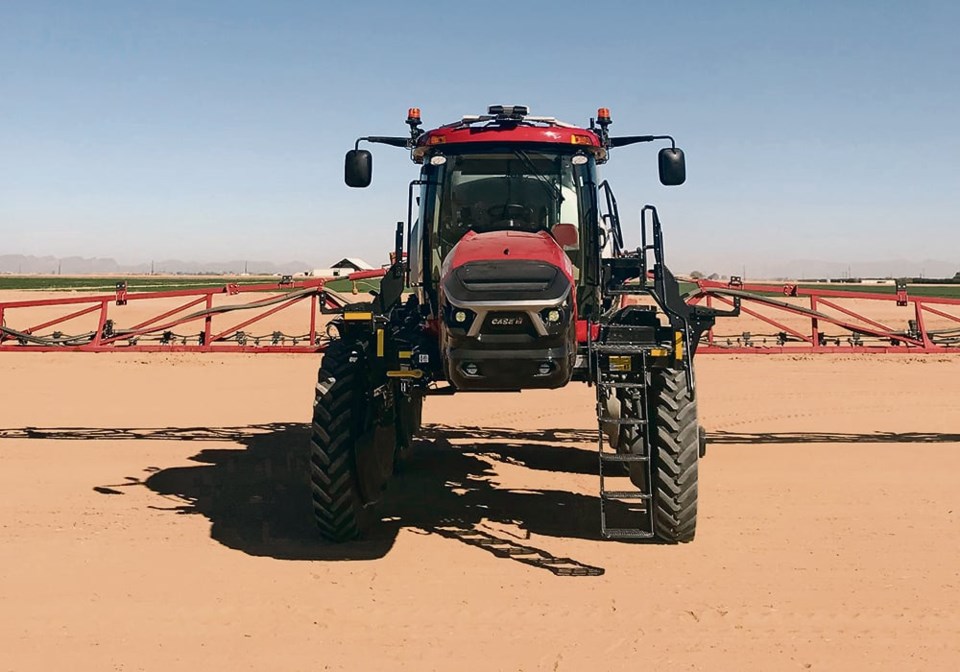WESTERN PRODUCER — If it’s growing in a field and can be measured remotely, Jim Evangelopoulos and George Varvarelis want to analyze it. The Greek inventors have developed a technology that provides applicators with variable rate instructions on the go.
Augmenta is a cab-mounted system with five 4K multispectral cameras, each working in a different wavelength. Artificial intelligence analyzes the plants then makes real time VR instructions that control the application of liquid and solid nutrients, plant growth regulators, fungicides, desiccants and defoliants. Augmenta processes data quickly enough to be accurate at ground speeds up to 20 mph.
Evangelopoulos grows wheat and canola on his farm in Greece. Electronics engineer by profession, he took on the challenge of applying multispectral technology analyze crops in the field. This winter he and Varvarelis sold Augmenta to CNHi.
Augmenta is available through the CNH/Raven and independent dealers such as Kelteck Ag in Grand Coulee Sask.. Kellen Huber of Kelteck Ag said his clients can use Augmenta data as a validation tool to make sure soil interventions are paying off as expected.
Huber said, “The system identifies plants and objects in front of the sprayer the same way as the human eye. The human field of vision is 180 degrees. The Augmenta field of vision is a full 125 degrees. It detects field variability and objects people normally would not see.
“Augmenta does depth perception. The algorithms can distinguish between a live corn stalk and a harvested corn stalk or tell the difference between a wheat plant and a thistle, based on shape, and colour and other parameters.
“Farmers use all kinds of maps, soil tests and tissue tests but there’s never real time meaning to them. With Augmenta, the data on the map relates directly to what’s happening with the plant at that exact moment in time. It uses an array of multispectral sensors, NDVI and NIR with real-time AI algorithms to gauge plant performance.”
Huber says a camera gathers more information than a sensor. The system generates thousands of data points per acre with a 138-foot boom travelling 20 miles per hour. It identifies everything in front of it for about 65 feet.
The system is compatible with ISOBUS, it can retrofit to old equipment, or it can connect via custom CAN protocol. It instantly calculates the required crop input dosage as the sprayer moves along the field. Identification of different areas is automatic and self-calibrating with no operator action required.
“Augmenta reads, analyzes and decides in real time. Then we send a command to the spreader or sprayer to change the dose according to the needs. When the operation is done, all data is uploaded to the cloud and the farmer can see maps and statistics from the operation,” Evangelopoulos said.
VR Fertility: By matching fertilizer input to current growing conditions of the crop, Augmenta’s N-VRA service maximizes the efficacy of every unit of fertilizer. This allows customers to apply the right rate at the right time and location. This typically yields an overall reduction in fertilizer applied and can increased yields.
VR PGR: Excessive vegetative growth is inhibited by delivering the optimal plant growth regulator rate at the right place on the field at the right time. Augmenta’s biomass driven PGR algorithm matches plant biomass to application rate resulting in a reduction in applied chemical and increase field uniformity. The algorithm uses an index map to assess and categorize plant biomass of different areas within the field in real time. It adjusts the PGR rate accordingly.
VR Fungicide: Augmenta is auto-calibrated to produce a vegetation index map under variable conditions to apply protective products. When biomass is higher, wind doesn’t move as easily and humidity remains longer, which increases the risk of disease. This makes it harder to cover the whole plant with disease-preventing chemical. Therefore, the dose will be increased where the biomass is higher. If biomass is smaller the risk is smaller, so rates can be reduced to the lower range on the product label.
VR Harvest Aid Desiccation: Desiccants are typically applied with a flat rate across the field, even in areas where no desiccation is needed. Augmenta’s biomass and chlorophyll-based Harvest Aid algorithms help reduce the amount of harvest aid chemicals applied while maintaining harvestability and crop quality.
The system tells the controller when there’s an area with high NDVI, where the crop is heavier and the biomass has not dried down. Areas with high biomass are given a high rate of product. Whereas rates can be reduced in areas with lower biomass readings.
“In lentils, for example, you might put down 15 gallons in the moderate growth area. That might go up to 20 gallons in dense biomass and then drop down to 10 gallons in lighter crop,” Huber said.
Huber has a half dozen units for sale this spring. List price is $34,900.




